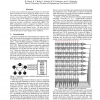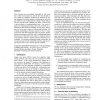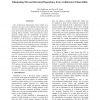24 search results - page 5 / 5 » Partial Error Masking to Reduce Soft Error Failure Rate in L... |
DATE
2006
IEEE
13 years 11 months ago
2006
IEEE
As devices are scaled to the nanoscale regime, it is clear that future nanodevices will be plagued by higher soft error rates and reduced noise margins. Traditional implementation...
DAC
2009
ACM
14 years 5 months ago
2009
ACM
State elements are increasingly vulnerable to soft errors due to their decreasing size, and the fact that latched errors cannot be completely eliminated by electrical or timing ma...
HPCA
2009
IEEE
14 years 5 months ago
2009
IEEE
The Architectural Vulnerability Factor (AVF) of a hardware structure is the probability that a fault in the structure will affect the output of a program. AVF captures both microa...
TDSC
2010
13 years 3 months ago
2010
—Soft errors (or Transient faults) are temporary faults that arise in a circuit due to a variety of internal noise and external sources such as cosmic particle hits. Though soft ...



